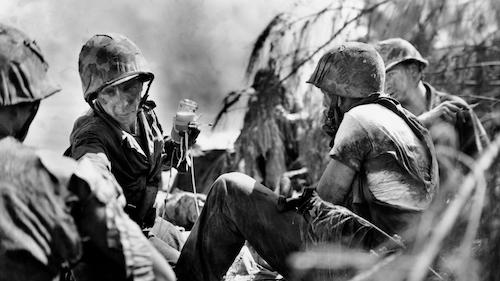Communiqué
Final episode of Ken Burns and Lynn Novick “The War” – November 10 at 9 pm
< < Back to final-episode-of-ken-burns-and-lynn-novick-the-war-november-10-at-9-pmThe War
Final Episode
November 10 at 9 pm
A World Without War – (March 1945 – December 1945)
In spring 1945, although the numbers of dead and wounded have more than doubled since D-Day, the people of Mobile, Sacramento, Waterbury and Luverne understand all too well that there will be more bad news from the battlefield before the war can end.
That March, when Americans go to the movies, President Franklin Roosevelt warns them in a newsreel that although the Nazis are on the verge of collapse, the final battle with Japan could stretch on for years. In the Pacific, Eugene Sledge of Mobile is once again forced to enter what he calls “the abyss” in the battle for the island of Okinawa – the gateway to Japan.
 Glenn Frazier of Alabama, one of 168,000 Allied prisoners of war still in Japanese hands, celebrates the arrival of carrier planes overhead, but despairs of ever getting out of Japan alive. In mid-April, Americans are shocked by news bulletins announcing that President Roosevelt is dead; many do not even know the name of their new president, Harry Truman.
Glenn Frazier of Alabama, one of 168,000 Allied prisoners of war still in Japanese hands, celebrates the arrival of carrier planes overhead, but despairs of ever getting out of Japan alive. In mid-April, Americans are shocked by news bulletins announcing that President Roosevelt is dead; many do not even know the name of their new president, Harry Truman.
Meanwhile, in Europe, as Allied forces rapidly push across Germany from the east and west, American and British troops, including Burnett Miller of Sacramento, Dwain Luce of Mobile and Ray Leopold of Waterbury, discover for themselves the true horrors of the Nazis’ industrialized barbarism – at Buchenwald, Ludwigslust, Dachau, Hadamar, Mauthausen and hundreds of other concentration camps. Finally, on May 8, with their country in ruins and their fuehrer dead by his own hand, the Nazis surrender. But as Eugene Sledge remembers, to the Marines and soldiers still fighting in the Pacific, “No one cared much. Nazi Germany might as well have been on the moon.”
The battle on Okinawa grinds on until June, and when it is finally over, 92,000 Japanese soldiers, as well as tens of thousands of Okinawan civilians, have been killed. Okinawa also is the worst battle of the Pacific for the Americans, and as they prepare to move on to Japan itself, still more terrible losses seem inevitable. Allied leaders at Potsdam set forth the terms under which they will agree to end the war, but for most of Japan’s rulers, despite the agony their people are enduring, unconditional surrender still remains unthinkable.
Then,on August 6, 1945, under orders from President Truman, an American plane drops a single atomic bomb on the city of Hiroshima, obliterating 40,000 men, women and children in an instant; 100,000 more die of burns and radiation within days (another 100,000 will succumb to radiation poisoning over the next five years). Two days later, Russia declares war against Japan. On August 9, a second American atomic bomb destroys the city of Nagasaki, and the rulers of Japan decide at last to give up – and the greatest cataclysm in history comes to an end. In the following months and years, millions of young men return home – to pick up the pieces of their lives and to try to learn how to live in a world without war.

